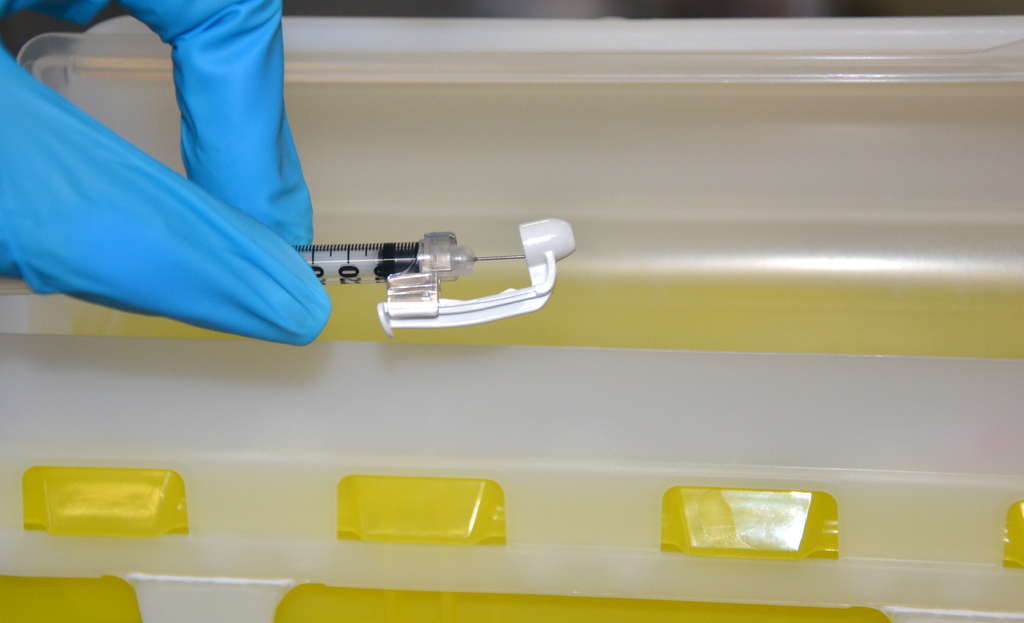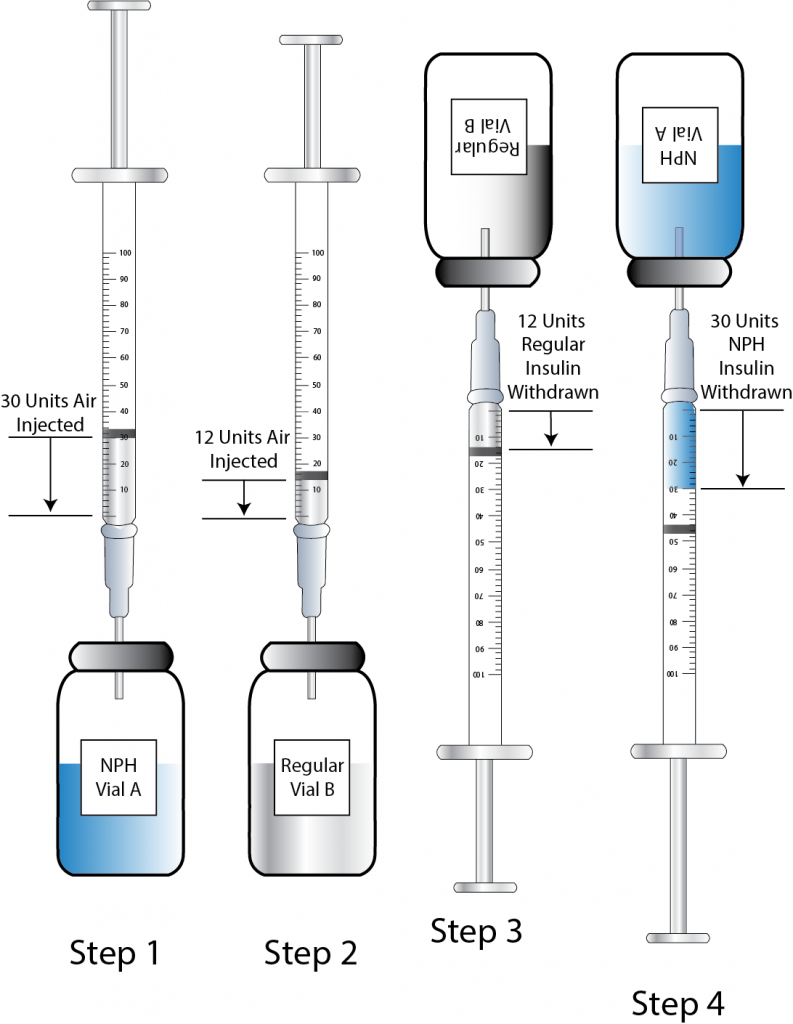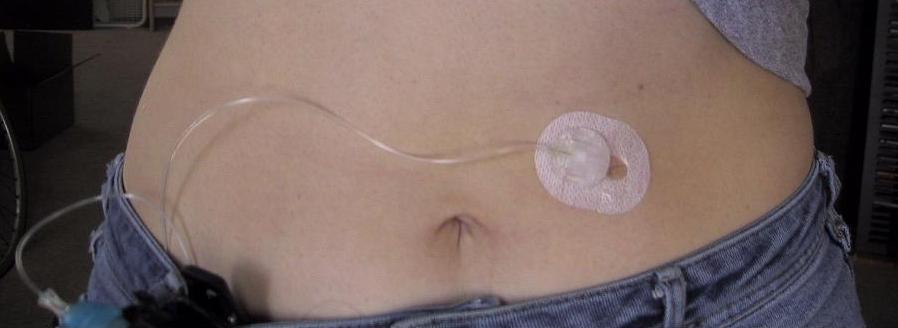18.5: Administración de medicamentos subcutáneos
- Page ID
- 121275
\( \newcommand{\vecs}[1]{\overset { \scriptstyle \rightharpoonup} {\mathbf{#1}} } \)
\( \newcommand{\vecd}[1]{\overset{-\!-\!\rightharpoonup}{\vphantom{a}\smash {#1}}} \)
\( \newcommand{\id}{\mathrm{id}}\) \( \newcommand{\Span}{\mathrm{span}}\)
( \newcommand{\kernel}{\mathrm{null}\,}\) \( \newcommand{\range}{\mathrm{range}\,}\)
\( \newcommand{\RealPart}{\mathrm{Re}}\) \( \newcommand{\ImaginaryPart}{\mathrm{Im}}\)
\( \newcommand{\Argument}{\mathrm{Arg}}\) \( \newcommand{\norm}[1]{\| #1 \|}\)
\( \newcommand{\inner}[2]{\langle #1, #2 \rangle}\)
\( \newcommand{\Span}{\mathrm{span}}\)
\( \newcommand{\id}{\mathrm{id}}\)
\( \newcommand{\Span}{\mathrm{span}}\)
\( \newcommand{\kernel}{\mathrm{null}\,}\)
\( \newcommand{\range}{\mathrm{range}\,}\)
\( \newcommand{\RealPart}{\mathrm{Re}}\)
\( \newcommand{\ImaginaryPart}{\mathrm{Im}}\)
\( \newcommand{\Argument}{\mathrm{Arg}}\)
\( \newcommand{\norm}[1]{\| #1 \|}\)
\( \newcommand{\inner}[2]{\langle #1, #2 \rangle}\)
\( \newcommand{\Span}{\mathrm{span}}\) \( \newcommand{\AA}{\unicode[.8,0]{x212B}}\)
\( \newcommand{\vectorA}[1]{\vec{#1}} % arrow\)
\( \newcommand{\vectorAt}[1]{\vec{\text{#1}}} % arrow\)
\( \newcommand{\vectorB}[1]{\overset { \scriptstyle \rightharpoonup} {\mathbf{#1}} } \)
\( \newcommand{\vectorC}[1]{\textbf{#1}} \)
\( \newcommand{\vectorD}[1]{\overrightarrow{#1}} \)
\( \newcommand{\vectorDt}[1]{\overrightarrow{\text{#1}}} \)
\( \newcommand{\vectE}[1]{\overset{-\!-\!\rightharpoonup}{\vphantom{a}\smash{\mathbf {#1}}}} \)
\( \newcommand{\vecs}[1]{\overset { \scriptstyle \rightharpoonup} {\mathbf{#1}} } \)
\( \newcommand{\vecd}[1]{\overset{-\!-\!\rightharpoonup}{\vphantom{a}\smash {#1}}} \)
Las inyecciones subcutáneas se administran en la capa de tejido adiposo llamada “subcutis” debajo de la dermis. Vea una imagen de la capa de subcutis (hipodermis) en la Figura\(\PageIndex{1}\). [1] Los medicamentos inyectados en la capa subcutánea se absorben a un ritmo lento y constante.

Sitios anatómicos
Los sitios para inyecciones subcutáneas incluyen la cara lateral externa de la parte superior del brazo, el abdomen (desde debajo del margen costal hasta la cresta ilíaca y a más de dos pulgadas del ombligo), la parte superior anterior de los muslos, la parte superior de la espalda y el área glútea ventral superior. [2] Ver Figura\(\PageIndex{2}\) [3] para una ilustración de los sitios de inyección subcutánea de uso común. Estas áreas tienen grandes áreas superficiales que permiten la rotación de las inyecciones subcutáneas dentro del mismo sitio cuando corresponda.

Antes de inyectar el medicamento, inspeccione el área de la piel. Evite las áreas de la piel que estén magulladuras, abiertas, con cicatrices o sobre prominencias óseas. Los padecimientos médicos que perjudican el flujo sanguíneo a un área tisular contraindican el uso de inyecciones subcutáneas en esa área. Por ejemplo, si un paciente tiene una infección en un área de su piel llamada “celulitis”, entonces no se deben administrar inyecciones subcutáneas en esa área.
Descripción del Procedimiento
Las enfermeras seleccionan el tamaño de aguja apropiado para la inyección subcutánea en función del tamaño del paciente. Las agujas subcutáneas varían en calibre de 25-31 y en longitud de ½ pulgada a pulgada. Antes de administrar la inyección, determine la cantidad de tejido subcutáneo presente y use esta información para seleccionar la longitud de la aguja. Se utiliza un ángulo de 45 o 90 grados para una inyección subcutánea. Se usa un ángulo de 90 grados para pacientes adultos de tamaño normal u pacientes obesos, y un ángulo de 45 grados se usa para pacientes que son delgados o tienen menos tejido adiposo en el sitio de inyección. El volumen de solución en una inyección subcutánea no debe ser superior a 1 mL para adultos y 0.5 mL para niños. Es posible que cantidades mayores no se absorban adecuadamente y pueden causar un aumento de las molestias para el paciente. [4]
Al administrar una inyección subcutánea, evaluar al paciente por cualquier contraindicación para recibir el medicamento. Aplique guantes no estériles después de realizar la higiene de las manos para reducir su riesgo de exposición a la sangre. Colocar al paciente en una posición cómoda y seleccionar un sitio apropiado para la inyección. Limpie el sitio con un hisopo con alcohol o un hisopo antiséptico durante 30 segundos con un movimiento firme y circular, y luego deje que el sitio se seque. Permitir que la piel se seque evita introducir alcohol en el tejido, lo que puede ser irritante e incómodo. Retire la tapa de la aguja con la mano no dominante, tirando de ella directamente para evitar lesiones por pinchazo de aguja. Sujete y pellizque el área seleccionada como lugar de inyección. [5] Ver Figura\(\PageIndex{3}\) [6] para una imagen de una enfermera agarrando la parte posterior de la parte superior del brazo de un paciente con la mano no dominante en preparación de una inyección subcutánea en el sitio anatómico indicado con una “X”

Sostenga la jeringa en la mano dominante entre el pulgar y el índice como un dardo. Inserte la aguja rápidamente en un ángulo de 45 a 90 grados, dependiendo del tamaño del paciente y la cantidad de tejido adiposo. Después de que la aguja esté en su lugar, libere el tejido con su mano no dominante. Con su mano dominante, inyecte el medicamento a razón de 10 segundos por mL. Evite mover la jeringa. [7] Ver Figura\(\PageIndex{4}\) [8] para una imagen de una inyección subcutánea.

Al inyectar heparina o al usar una pluma de insulina, continúe pellizcando la piel durante la inyección y libere el pliegue cutáneo inmediatamente antes de retirar la aguja.
Retirar la aguja rápidamente en el mismo ángulo en el que se insertó. Usando una gasa estéril, aplique una presión suave en el sitio después de retirar la aguja. No masajear el sitio. El masaje después de una inyección de heparina puede contribuir a la formación de un hematoma. No recapitular la aguja para evitar pinchar uno mismo. Aplique el escudo de seguridad y deseche la jeringa/aguja en un recipiente para objetos punzantes. Ver Figura\(\PageIndex{5}\)[9] for an image of a needle after the safety shield has been applied. Remove gloves and perform hand hygiene.[10]

Examples of common medications administered via subcutaneous injection include insulin and heparin. Special considerations for each of these medications are discussed below.
Insulin Injections
Insulin is considered a high-alert medication requiring special care to prevent medication errors. Care must be taken to ensure the correct type and amount of insulin are administered at the correct time. It is highly recommended to have insulin dosages double-checked by another nurse before administration because of the potential for life-threatening adverse effects that can occur due to medication errors. Some agencies require this second safety check.
Only insulin syringes should be used to administer insulin injection. Insulin syringes are supplied in 30-, 50-, or 100-unit measurements, so read the barrel increments (calibration) carefully. Insulin is always ordered and administered in unit dosage. Insulin dosage may be based on the patient’s pre-meal blood sugar reading and a sliding scale protocol that indicates the number of units administered based on the blood sugar reading.[11],[12]
There are rapid-, short-, intermediate-, and long-acting insulins. For each type of insulin, it is important to know the onset, peak, and duration of the insulin so that it can be timed appropriately with the patient’s food intake. It is essential to time the administration of insulin with food intake to avoid hypoglycemia. When administering insulin before a meal, always ensure the patient is not nauseated and is able to eat. Short- or rapid-acting insulin may be administered up to 15-30 minutes before meals. Intermediate insulin is typically administered twice daily, at breakfast and dinner, and long-acting insulin is typically administered in the evening.[13],[14]
When administering cloudy insulin preparations such as NPH insulin (Humulin-N), gently roll the vial between the palms of your hands to resuspend the medication before withdrawing it from the vial.[15],[16] See Figure \(\PageIndex{6}\)[17] for an image of insulin NPH that is cloudy in color.

Preparing Insulin in a Syringe
When withdrawing insulin from a vial, check the insulin vial to make sure it is the right kind of insulin and that there are no clumps or particles in it. Also, make sure the insulin is not past its expiration date. Pull air into the syringe to match the amount of insulin you plan to remove. Hold the syringe like a pencil and insert the needle into the rubber stopper on the top of the vial. Push the plunger down until all of the air is in the bottle. This helps to keep the right amount of pressure in the bottle and makes it easier to draw up the insulin. With the needle still in the vial, turn the bottle and syringe upside down (vial above syringe). Pull the plunger to fill the syringe to the desired amount. Check the syringe for air bubbles. If you see any large bubbles, push the plunger until the air is purged out of the syringe. Pull the plunger back down to the desired dose. Remove the needle from the bottle. Be careful to not let the needle touch anything until you are ready to inject.[18]
Mixing Two Types of Insulin
If a patient is ordered two types of insulin, some insulins may be mixed together in one syringe. For example, insulin NPH (Novolin-N) can be mixed with insulin regular (Humulin-R), insulin aspart (Novolog), or insulin lispro (Humalog). However, some types of insulin cannot be mixed with other insulin, such as insulin glargine (Lantus) or insulin detemir (Levemir).[19],[20]
When mixing insulin, gather your insulin supplies. Check the insulin vials to make sure they are the right kinds of insulin, there are no clumps or particles in them, and the expiration dates have not passed. Gently mix intermediate or premixed insulin by turning the vial on its side and rolling it between the palms of your hands. Prepare the insulin vials by injecting air into the intermediate insulin vial. Remove the cap from the needle. With the vial of insulin below the syringe, inject an amount of air equal to the dose of intermediate insulin that you will be taking. Do not draw out the insulin into the syringe yet. Remove the needle from the vial. Inject air into the rapid-acting insulin vial equal to the rapid-acting insulin dose. With the needle still in the vial, turn the vial upside down (vial above the syringe) and pull the plunger to fill the syringe with the desired dose. Check the syringe for air bubbles. If you see any large bubbles, push the plunger until the air is purged out of the syringe. Pull the plunger back down to the desired dose. Remove the needle from the vial and recheck your dose. Insert the needle into the vial of cloudy insulin. Turn the vial upside down (vial above syringe) and pull the plunger to draw the dose of intermediate-acting insulin. Because the short-acting insulin is already in the syringe, pull the plunger to the total number of units you need. Do not inject any of the insulin back into the vial because the syringe now contains a mixture of intermediate- and rapid-acting insulin. Remove the needle from the vial and be careful to not let the needle touch anything until you are ready to inject.[21]
When mixing insulin, it is important to always draw up the short-acting insulin first to prevent it from being contaminated with the long-acting insulin. See Figure \(\PageIndex{7}\)[22] for an illustration of the order to follow when mixing insulin.

One anatomic region should be selected for a patient’s insulin injections to maintain consistent absorption, and then sites should be rotated within that region. The abdomen absorbs insulin the fastest, followed by the arms, thighs, and buttocks. It is no longer necessary to rotate anatomic regions, as was once done, because newer insulins have a lower risk for causing hypertrophy of the skin.[23],[24]
Insulin Pens
Insulin pens are a newer technology designed to be used multiple times for a single person, using a new needle for each injection. See Figure \(\PageIndex{8}\)[25] for an image of an insulin pen. Insulin pens must never be used for more than one person. Regurgitation of blood into the insulin cartridge can occur after injection, creating a risk of blood-borne pathogen transmission if the pen is used for more than one person, even when the needle is changed.[26] Prefilled insulin pens consist of a prefilled cartridge of insulin to which a special, single-use needle is attached. When using an insulin pen for subcutaneous insulin administration, a few additional steps must be taken according to manufacturer guidelines. The needle should be primed with two units of insulin, and then the dosage should be dialed in the dose window. The pen should be held with the hand using four fingers so that the thumb can be used to fully depress the plunger button. The pen should be left in place for ten seconds after the insulin is injected to aid in absorption.[27]
Insulin pens are often prescribed for home use because of their ease of use. Patients and family members must be educated on how to correctly use an insulin pen before discharge. To evaluate a patient’s knowledge of how to correctly administer insulin, ask them to “return demonstrate” the procedure to you.[28],[29]

Special Considerations for Insulin
- Insulin vials are stored in the refrigerator until they are opened. When removed, it should be labelled with an open date and expiration date according to agency policy. When a vial is in use, it should be at room temperature. Do not inject cold insulin because this can cause discomfort.
- Patients who take insulin should monitor their blood sugar (glucose) levels as prescribed by their health care provider.
- Vials of insulin should be inspected prior to use. Any change in appearance may indicate a change in potency. Check the expiration date and do not use it if it has expired.
- All health care workers should be aware of the signs and symptoms of hypoglycemia. Signs and symptoms of hypoglycemia include fruity breath, restlessness, agitation, confusion, slurring of words, clammy skin, inability to concentrate or follow commands, hunger, and nausea. Follow agency policy regarding hypoglycemic reactions.[30]
For more information about injecting insulin, read the following American Association of Diabetes Educators PDF:
Insulin Injection Know-How
For additional details about different types of insulin, hypoglycemia, and safety considerations when administering insulin, visit the “Antidiabetics” section of the “Endocrine” chapter in Open RN Nursing Pharmacology.
Heparin Injections
Heparin is an anticoagulant medication used to treat or prevent blood clots. It comes in various strengths and can be administered subcutaneously or intravenously. Heparin is also considered a high-alert medication because of the potential life-threatening harm that can result from a medication error. See Figure \(\PageIndex{9}\)[32] for an image of a prefilled syringe of enoxaparin (Lovenox), a low-molecular weight heparin, that is typically dispensed in prefilled syringes. Review specific guidelines regarding heparin administration in Table \(\PageIndex{1}\).[33]

For more information about heparin, visit the “Blood Coagulation Modifiers” section of the “Cardiovascular and Renal System” chapter in Open RN Nursing Pharmacology.
| Guidelines | Additional Information |
|---|---|
| Remember that heparin is considered a high-alert medication. | Heparin is available in vials and prefilled syringes in a variety of concentrations. Because of the dangerous adverse effects of the medication, it is considered a high-alert medication. Always follow agency policy regarding the preparation and administration of heparin. |
| Rotate heparin injection sites. | It is important to rotate heparin sites to avoid bruising in one location. Heparin is absorbed best in the abdominal area, at least 2 inches (5 cm.) away from the umbilicus. |
| Know the risks associated with heparin. | There are many risks associated with the administration of heparin, including bleeding, hematuria, hematemesis, bleeding gums, and melena. Monitor, document, and report these side effects when a patient is receiving heparin. |
| Review lab values. | Review lab values (PTT and aPTT) before and after heparin administration. If injecting low-molecular weight heparin (enoxaparin), review platelet count because heparin can cause thrombocytopenia. |
| Follow administration standards for prepackaged heparin and enoxaparin syringes. | Many agencies use prepackaged heparin and enoxaparin syringes. Always follow the standards for safe medication administration when using prefilled syringes. |
| Assess patient conditions prior to administration. | Some medical conditions increase the patient’s risk for hemorrhage (severe bleeding), such as recent childbirth, severe kidney and liver disease, cerebral or aortic aneurysm, and cerebral vascular accidents (CVA). |
| Assess other medications and diet. | Over-the-counter (OTC) herbal medications, such as garlic, ginger, and horse chestnut, may interact with heparin. Additional medications that may interact or cause increased risk of bleeding include aspirin, NSAIDs, cephalosporins, antithyroid agents, thrombolytics, and probenecids. Foods like green leafy vegetables can alter the therapeutic effect of heparin. |
Device Technology
A jet injector is a medical device used for vaccinations and other subcutaneous injections that uses a high-pressure, narrow stream of fluid to penetrate the skin instead of a hypodermic needle. An example of a flu vaccine approved for administration to adults aged 18-64 is AFLURIA © Quadrivalent. The most common injection-site adverse reactions of the jet injector flu vaccine up to seven days post-vaccination were tenderness, swelling, pain, redness, itching, and bruising.[35] Insulin can also be successfully administered via a jet injector, with research demonstrating improved glucose control because the insulin is spread out over a larger area of tissue and enters the bloodstream faster than when administered by an insulin pen or needle. Patients have indicated preference for insulin delivered by the jet injector compared to the insulin pen or syringe because it is needle-free with less tissue injury and pain as compared to the needle injection.[36] See Figure \(\PageIndex{10}\)[37] for an image comparing insulin delivery devices.

Another type of new technology used to continuously deliver subcutaneous insulin is the insulin pump. Pumps are a computerized device attached to the body, either with tubing or attached to the skin. They are programmed to release small doses of insulin (continuously or as a surge bolus dose) close to mealtime to control the rise in blood sugar after a meal. They work by closely mimicking the body’s normal release of insulin. Insulin doses are delivered through a flexible plastic tube called a catheter. With the aid of a small needle, the catheter is inserted through the skin into the fatty tissue and is taped in place.[38] See Figure \(\PageIndex{11}\)[39] for an image of an insulin pump infusion set attached to a patient.

- “HumanSkinDiagram.jpg” by Daniel de Souza Telles is licensed under CC BY-SA3.0↵
- This work is a derivative of Clinical Procedures for Safer Patient Care by British Columbia Institute of Technology and is licensed under CC BY 4.0↵
- “Subcutaneous-injection-sites-274x300.png” by British Columbia Institute of Technology is licensed under CC BY 4.0. Access for free at https://opentextbc.ca/clinicalskills/chapter/6-7-intradermal-subcutaneous-and-intramuscular-injections/. ↵
- This work is a derivative of Clinical Procedures for Safer Patient Care by British Columbia Institute of Technology and is licensed under CC BY 4.0↵
- This work is a derivative of Clinical Procedures for Safer Patient Care by British Columbia Institute of Technology and is licensed under CC BY 4.0↵
- “Upper Posterior Arm” by Meredith Pomietlo for Chippewa Valley Technical College is licensed under CC BY 4.0↵
- This work is a derivative of Clinical Procedures for Safer Patient Care by British Columbia Institute of Technology and is licensed under CC BY 4.0↵
- “Book-pictures-2015-650.jpg” by British Columbia Institute of Technology is licensed under CC BY 4.0. Access for free at https://opentextbc.ca/clinicalskills/chapter/6-7-intradermal-subcutaneous-and-intramuscular-injections/. ↵
- “Sept-22-2015-040.jpg” by British Columbia Institute of Technology is licensed under CC BY 4.0. Access for free at https://opentextbc.ca/clinicalskills/chapter/6-7-intradermal-subcutaneous-and-intramuscular-injections/↵
- This work is a derivative of Clinical Procedures for Safer Patient Care by British Columbia Institute of Technology and is licensed under CC BY 4.0↵
- This work is a derivative of Clinical Procedures for Safer Patient Care by British Columbia Institute of Technology and is licensed under CC BY 4.0↵
- American Diabetes Association. (n.d.). Insulin basics. https://www.diabetes.org/diabetes/medication-management/insulin-other-injectables/insulin-basics↵
- This work is a derivative of Clinical Procedures for Safer Patient Care by British Columbia Institute of Technology and is licensed under CC BY 4.0↵
- American Diabetes Association. (n.d.). Insulin basics. https://www.diabetes.org/diabetes/medication-management/insulin-other-injectables/insulin-basics↵
- This work is a derivative of Clinical Procedures for Safer Patient Care by British Columbia Institute of Technology and is licensed under CC BY 4.0↵
- American Diabetes Association. (n.d.). Insulin basics. https://www.diabetes.org/diabetes/medication-management/insulin-other-injectables/insulin-basics↵
- “insulin-syringe” by biologycorner is licensed under CC BY-NC 2.0↵
- American Association of Diabetes Educators. (n.d.). Insulin injection know-how. https://www.diabeteseducator.org/docs/default-source/legacy-docs/_resources/pdf/general/Insulin_Injection_How_To_AADE.pdf↵
- This work is a derivative of Clinical Procedures for Safer Patient Care by British Columbia Institute of Technology and is licensed under CC BY 4.0↵
- American Diabetes Association. (n.d.). Insulin basics. https://www.diabetes.org/diabetes/medication-management/insulin-other-injectables/insulin-basics↵
- American Association of Diabetes Educators. (n.d.). Insulin injection know-how. https://www.diabeteseducator.org/docs/default-source/legacy-docs/_resources/pdf/general/Insulin_Injection_How_To_AADE.pdf↵
- “Mixing Insulin” by Meredith Pomietlo for Chippewa Valley Technical College is licensed under CC BY 4.0↵
- This work is a derivative of Clinical Procedures for Safer Patient Care by British Columbia Institute of Technology and is licensed under CC BY 4.0↵
- American Diabetes Association. (n.d.). Insulin basics. https://www.diabetes.org/diabetes/medication-management/insulin-other-injectables/insulin-basics↵
- “Insulin_pen_(labeled).jpg” by User:Wesalius is licensed under CC BY 4.0↵
- Centers for Disease Control and Prevention. (2012, January 4). CDC clinical reminder: Insulin pens must never be used for more than one person. https://www.cdc.gov/injectionsafety/clinical-reminders/insulin-pens.html↵
- American Association of Diabetes Educators. (n.d.). Insulin injection know-how. https://www.diabeteseducator.org/docs/default-source/legacy-docs/_resources/pdf/general/Insulin_Injection_How_To_AADE.pdf↵
- This work is a derivative of Clinical Procedures for Safer Patient Care by British Columbia Institute of Technology and is licensed under CC BY 4.0↵
- American Diabetes Association. (n.d.). Insulin basics. https://www.diabetes.org/diabetes/medication-management/insulin-other-injectables/insulin-basics↵
- American Diabetes Association. (n.d.). Insulin basics. https://www.diabetes.org/diabetes/medication-management/insulin-other-injectables/insulin-basics↵
- RegisteredNurseRN. (2016, July 15). How to mix insulin NPH and regular insulin nursing | Mixing insulin clear to cloudy. [Video]. YouTube. All rights reserved. Video used with permission. https://youtu.be/O_kXOnrYYRA. ↵
- “syringe-103060_1920.jpg” by Stux from Pixabay is licensed under CC0 . ↵
- This work is a derivative of Clinical Procedures for Safer Patient Care by British Columbia Institute of Technology and is licensed under CC BY 4.0↵
- This work is a derivative of Clinical Procedures for Safer Patient Care by British Columbia Institute of Technology and is licensed under CC BY 4.0↵
- Centers for Disease Control and Prevention. (2020, August 20). Flu vaccination by jet injector. https://www.cdc.gov/flu/prevent/jet-injector.htm↵
- Guo, L., Xiao, X., Sun, X., & Qi, C. (2017). Comparison of jet injector and insulin pen in controlling plasma glucose and insulin concentrations in type 2 diabetic patients. Medicine, 96(1), e5482. doi.org/10.1097/MD.0000000000005482↵
- “Insulin_Delivery_Devices.png” by BruceBlaus is licensed under CC BY-SA 4.0↵
- American Diabetes Association. (n.d.). Device technology. https://www.diabetes.org/diabetes/device-technology↵
- "insulin pump day 1" by Erin Stevenson O’Connor is licensed under CC BY-SA 2.0↵


